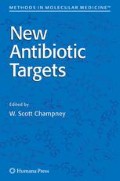Summary
Aminoacyl-tRNA synthetases (aa-RS) attracted interest as potential targets for new antibacterial compounds. Most organisms express 20 aa-RSs: one for each amino acid. Aa-RSs are essential proteins in all living organisms. When one aa-RS is inhibited, the corresponding tRNA is not charged and is therefore unavailable for translation. This leads to protein synthesis inhibition, which in turn causes cell growth arrest. Consequently, each compound that inhibits any of the aa-RS could be a potential antibacterial agent. Only one aa-RS inhibitor, the Ile-RS inhibitor mupirocin, is currently marketed as an antibacterial agent. We focused on phenylalanyl (Phe)-tRNA synthetase (Phe-RS), but the described methods are not restricted to Phe-RS and might be adapted to other aa-RS.
Access this chapter
Tax calculation will be finalised at checkout
Purchases are for personal use only
References
Beyer, D., Kroll, H. P., Endermann, R., Schiffer, G., Siegel, S., Bauser, M., Pohlmann, J., Brands, M., Ziegelbauer, K., Haebich, D., Eymann, C., and Brotz-Oesterhelt, H. (2004) New class of bacterial phenylalanyl-tRNA synthetase inhibitors with high potency and broad-spectrum activity. Antimicrob. Agents Chemother. 48, 525–532.
Lacks, S., and Hotchkiss, R. D. (1960). A study of the genetic material determining an enzyme activity in Pneumococcus. Biochim. Biophys. Acta 39, 508–518.
Nierhaus, K. H., and Dohme, F. (1979). Total reconstitution of 50S subunits from Escherichia coli ribosomes. Methods in Enzymology LIX, 443–449.
Liu, H. (2000). Measurement of blood plasma amino acids in ultrafiltrates by high-performance liquid chromatography with automatic precolumn O-phthaldialdehyde derivatization. Methods Mol. Biol. 159, 123–140.
Acknowledgments
We thank Rainer Endermann (Bayer Healthcare AG) for performing the animal experiment and Werner Schroeder (Bayer Healthcare AG) for determination of the amino acid concentration in mouse plasma.
Author information
Authors and Affiliations
Editor information
Editors and Affiliations
Rights and permissions
Copyright information
© 2008 Humana Press Inc.
About this protocol
Cite this protocol
Dieter, B., Hein, P.K., Brötz-Oesterhelt, H. (2008). Methods to Assay Inhibitors of tRNA Synthetase Activity. In: Champney, W.S. (eds) New Antibiotic Targets. Methods In Molecular Medicine™, vol 142. Humana Press. https://doi.org/10.1007/978-1-59745-246-5_5
Download citation
DOI: https://doi.org/10.1007/978-1-59745-246-5_5
Publisher Name: Humana Press
Print ISBN: 978-1-58829-915-4
Online ISBN: 978-1-59745-246-5
eBook Packages: Springer Protocols

